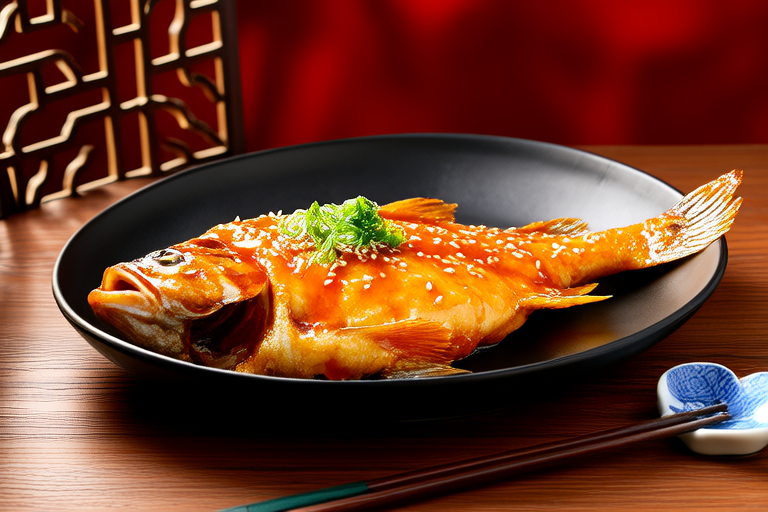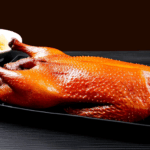- Introduction to Traditional Shandong Sweet and Sour Carp
Traditional Shandong Sweet and Sour Carp is a classic dish that has been enjoyed for centuries in the Shandong region of China. This dish is not only renowned for its unique flavor but also for its rich cultural heritage. The dish features a whole carp, which is first fried until crispy and then bathed in a sweet and sour sauce made from a combination of vinegar, sugar, soy sauce, and other seasonings. The result is a dish that is both visually appealing and delicious.
The origins of this dish can be traced back to the Qing Dynasty, where it was served at banquets for emperors and nobility. Over time, the dish has evolved and become a staple in many households across Shandong. Today, it is considered one of the most iconic dishes of Chinese cuisine and is beloved by food enthusiasts around the world.
In this article, we will explore the history and cultural significance of this dish, as well as provide a detailed recipe that you can follow at home. We will also discuss the key ingredients and techniques involved in preparing this dish, so that you can achieve the perfect balance of flavors and textures.
- The Cultural Significance of Traditional Shandong Sweet and Sour Carp
Traditional Shandong Sweet and Sour Carp holds great cultural significance in Chinese cuisine. It is often served during important celebrations such as weddings, birthdays, and festivals. The dish is believed to bring good fortune and prosperity to those who eat it, making it a popular choice for special occasions.
The use of fish in this dish also carries symbolic meaning. In Chinese culture, fish is associated with abundance and wealth, as the word for “fish” (鱼) sounds similar to the word for “surplus” (余). By serving this dish, hosts hope to bring their guests good luck and prosperity in the coming year.
Furthermore, the preparation of this dish requires skill and precision, reflecting the importance of craftsmanship in Chinese culinary traditions. The frying of the carp to achieve the perfect crispness, the balancing of flavors in the sweet and sour sauce, and the presentation of the dish all demonstrate the care and attention that goes into creating this iconic dish.
- The Key Ingredients for Traditional Shandong Sweet and Sour Carp
To prepare Traditional Shandong Sweet and Sour Carp, there are several key ingredients that you will need:
- Fresh carp: The quality of the fish is crucial to the success of this dish. Look for a fresh, firm carp that is free from any blemishes or discoloration.
- Vinegar: Rice vinegar or apple cider vinegar are commonly used in this dish. They provide the tangy flavor that balances out the sweetness of the sauce.
- Sugar: Granulated sugar or brown sugar can be used to add sweetness to the sauce. Honey can also be used as an alternative.
- Soy sauce: Dark soy sauce is preferred for its rich flavor and color. It adds depth to the sauce and enhances the overall taste of the dish.
- Garlic: Garlic cloves are crushed and sautéed to add aroma and flavor to the sauce.
- Ginger: Fresh ginger is grated and added to the sauce for its spicy and pungent flavor.
- Onion: Sliced onions are added to the sauce for extra flavor and texture.
- Tomato sauce: Tomato sauce is used to add color and acidity to the sauce.
- Water chestnuts: These crunchy vegetables are sliced and added to the sauce for their unique texture.
- Green pepper: Green bell peppers are sliced and added to the sauce for their vibrant color and mild sweetness.
These ingredients work together to create a balanced and harmonious flavor profile that is both sweet and sour. Each ingredient plays a vital role in bringing out the best in the dish, and careful attention should be paid to the selection and preparation of each one.
- Preparation and Cooking Techniques for Traditional Shandong Sweet and Sour Carp
The preparation and cooking techniques for Traditional Shandong Sweet and Sour Carp require precision and care. Here are some key steps to follow:
- Frying the Carp: The first step is to fry the carp until it is crispy on the outside and tender on the inside. To do this, pat the fish dry with paper towels and season it with salt and pepper. Heat oil in a large pan over medium-high heat until it reaches 375°F (190°C). Carefully place the fish in the hot oil and fry for about 8-10 minutes on each side, or until golden brown and crispy. Remove the fish from the oil and let it drain on a wire rack.
- Making the Sauce: While the fish is frying, prepare the sweet and sour sauce. In a separate pan, heat some oil over medium heat and sauté the garlic and ginger until fragrant. Add the sliced onions and cook for another minute. Stir in the tomato sauce, vinegar, sugar, soy sauce, and water chestnuts. Bring the mixture to a boil and let it simmer for about 5 minutes, or until the sauce thickens slightly. Finally, stir in the green peppers and adjust the seasoning to taste.
- Assembling the Dish: Once the sauce is ready, carefully place the fried carp on a serving platter. Pour the sweet and sour sauce over the fish, making sure to coat it evenly. Garnish with additional green peppers or water chestnuts if desired.
By following these steps, you can ensure that your Traditional Shandong Sweet and Sour Carp is perfectly prepared and cooked. The frying process is crucial for achieving the crispy exterior of the fish, while the sauce should be carefully balanced to achieve the right level of sweetness and acidity. With practice, you will be able to master this iconic dish and impress your guests with its delicious flavor and elegant presentation.
- Conclusion
Traditional Shandong Sweet and Sour Carp is a dish that not only satisfies the palate but also reflects the rich culinary traditions of China. Its history, cultural significance, and unique flavor profile make it a standout dish that continues to captivate food lovers around the world. By mastering the key ingredients and techniques involved in preparing this dish, you can bring a touch of Shandong’s culinary heritage to your own kitchen. Whether you’re hosting a special occasion or simply looking for a delicious meal to enjoy with family and friends, this iconic dish is sure to impress and delight.


